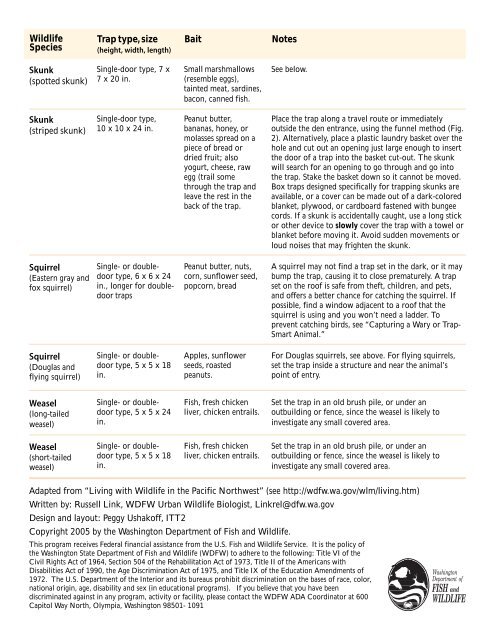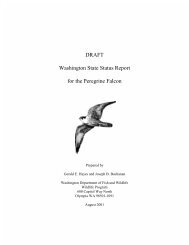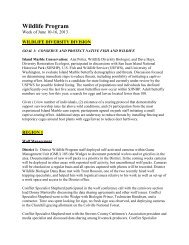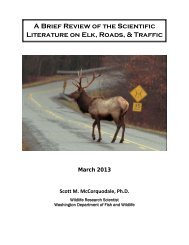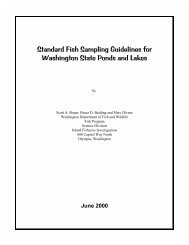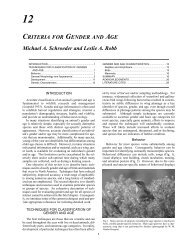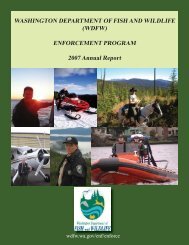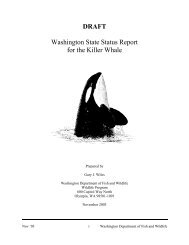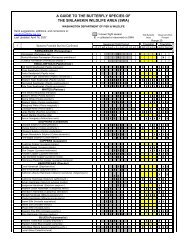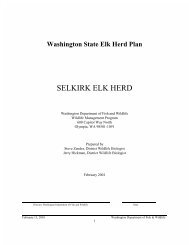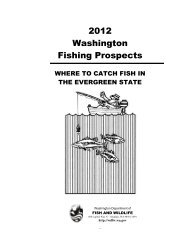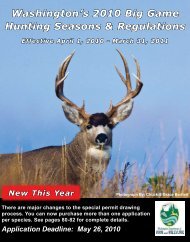Trapping Wildlife - Washington Department of Fish & Wildlife
Trapping Wildlife - Washington Department of Fish & Wildlife
Trapping Wildlife - Washington Department of Fish & Wildlife
You also want an ePaper? Increase the reach of your titles
YUMPU automatically turns print PDFs into web optimized ePapers that Google loves.
<strong>Wildlife</strong><br />
Species<br />
Skunk<br />
(spotted skunk)<br />
Skunk<br />
(striped skunk)<br />
Squirrel<br />
(Eastern gray and<br />
fox squirrel)<br />
Squirrel<br />
(Douglas and<br />
flying squirrel)<br />
Weasel<br />
(long-tailed<br />
weasel)<br />
Weasel<br />
(short-tailed<br />
weasel)<br />
Trap type, size<br />
(height, width, length)<br />
Single-door type, 7 x<br />
7 x 20 in.<br />
Single-door type,<br />
10 x 10 x 24 in.<br />
Single- or doubledoor<br />
type, 6 x 6 x 24<br />
in., longer for doubledoor<br />
traps<br />
Single- or doubledoor<br />
type, 5 x 5 x 18<br />
in.<br />
Single- or doubledoor<br />
type, 5 x 5 x 24<br />
in.<br />
Single- or doubledoor<br />
type, 5 x 5 x 18<br />
in.<br />
Bait Notes<br />
Small marshmallows<br />
(resemble eggs),<br />
tainted meat, sardines,<br />
bacon, canned fish.<br />
Peanut butter,<br />
bananas, honey, or<br />
molasses spread on a<br />
piece <strong>of</strong> bread or<br />
dried fruit; also<br />
yogurt, cheese, raw<br />
egg (trail some<br />
through the trap and<br />
leave the rest in the<br />
back <strong>of</strong> the trap.<br />
Peanut butter, nuts,<br />
corn, sunflower seed,<br />
popcorn, bread<br />
Apples, sunflower<br />
seeds, roasted<br />
peanuts.<br />
<strong>Fish</strong>, fresh chicken<br />
liver, chicken entrails.<br />
<strong>Fish</strong>, fresh chicken<br />
liver, chicken entrails.<br />
See below.<br />
Place the trap along a travel route or immediately<br />
outside the den entrance, using the funnel method (Fig.<br />
2). Alternatively, place a plastic laundry basket over the<br />
hole and cut out an opening just large enough to insert<br />
the door <strong>of</strong> a trap into the basket cut-out. The skunk<br />
will search for an opening to go through and go into<br />
the trap. Stake the basket down so it cannot be moved.<br />
Box traps designed specifically for trapping skunks are<br />
available, or a cover can be made out <strong>of</strong> a dark-colored<br />
blanket, plywood, or cardboard fastened with bungee<br />
cords. If a skunk is accidentally caught, use a long stick<br />
or other device to slowly cover the trap with a towel or<br />
blanket before moving it. Avoid sudden movements or<br />
loud noises that may frighten the skunk.<br />
A squirrel may not find a trap set in the dark, or it may<br />
bump the trap, causing it to close prematurely. A trap<br />
set on the ro<strong>of</strong> is safe from theft, children, and pets,<br />
and <strong>of</strong>fers a better chance for catching the squirrel. If<br />
possible, find a window adjacent to a ro<strong>of</strong> that the<br />
squirrel is using and you won’t need a ladder. To<br />
prevent catching birds, see “Capturing a Wary or Trap-<br />
Smart Animal.”<br />
For Douglas squirrels, see above. For flying squirrels,<br />
set the trap inside a structure and near the animal’s<br />
point <strong>of</strong> entry.<br />
Set the trap in an old brush pile, or under an<br />
outbuilding or fence, since the weasel is likely to<br />
investigate any small covered area.<br />
Set the trap in an old brush pile, or under an<br />
outbuilding or fence, since the weasel is likely to<br />
investigate any small covered area.<br />
Adapted from “Living with <strong>Wildlife</strong> in the Pacific Northwest” (see http://wdfw.wa.gov/wlm/living.htm)<br />
Written by: Russell Link, WDFW Urban <strong>Wildlife</strong> Biologist, Linkrel@dfw.wa.gov<br />
Design and layout: Peggy Ushak<strong>of</strong>f, ITT2<br />
Copyright 2005 by the <strong>Washington</strong> <strong>Department</strong> <strong>of</strong> <strong>Fish</strong> and <strong>Wildlife</strong>.<br />
This program receives Federal financial assistance from the U.S. <strong>Fish</strong> and <strong>Wildlife</strong> Service. It is the policy <strong>of</strong><br />
the <strong>Washington</strong> State <strong>Department</strong> <strong>of</strong> <strong>Fish</strong> and <strong>Wildlife</strong> (WDFW) to adhere to the following: Title VI <strong>of</strong> the<br />
Civil Rights Act <strong>of</strong> 1964, Section 504 <strong>of</strong> the Rehabilitation Act <strong>of</strong> 1973, Title II <strong>of</strong> the Americans with<br />
Disabilities Act <strong>of</strong> 1990, the Age Discrimination Act <strong>of</strong> 1975, and Title IX <strong>of</strong> the Education Amendments <strong>of</strong><br />
1972. The U.S. <strong>Department</strong> <strong>of</strong> the Interior and its bureaus prohibit discrimination on the bases <strong>of</strong> race, color,<br />
national origin, age, disability and sex (in educational programs). If you believe that you have been<br />
discriminated against in any program, activity or facility, please contact the WDFW ADA Coordinator at 600<br />
Capitol Way North, Olympia, <strong>Washington</strong> 98501- 1091


